Talented quilter and videographer, Pam Holland, takes us up close to the quilts at the Birmingham, England Quilt Show. You can play this on full screen by clicking the icon with the 2 arrows next to the sound icon.
Talented quilter and videographer, Pam Holland, takes us up close to the quilts at the Birmingham, England Quilt Show. You can play this on full screen by clicking the icon with the 2 arrows next to the sound icon.

Photo courtesy of Baba Blankets
One Woman's mission to help the Women of Africa
by Lilo Bowman
The greatest change often comes when one person decides to follow their dream. Names such as Ghandi or Martin Luther King represent the epitomy of this idealism. Often it only takes that individual's unending will and determination to make a significant impact in the lives of others. While in Houston for the recent Quilt Festival we met Aminata Brown, founder of Baba Blankets, and learned of the incredible journey she had taken in her effort to help the women of Ghana to be independent and self supporting members of society.
Brown had always dreamed of living in West Africa. Even as a child she felt this strong pull to live across the globe, but had no idea that she would one day be living in a part of the world that she had so often longed for. As a college undergraduate she worked in Dakar, Senegal for ten month to teach english to middle and high school students. She returned to Brown University to complete her degree in Literature and African Studies, but always with the intention of returning to West Africa as soon as financially possible. After graduation work as a management consultant allowed her to save with the majority of her income for her "Africa Nest Egg". After four years she finally had saved enough, and with the prospect of work in Ghana as an entrepreneurial business consultant she thougt her dream had come true. But life had another plan in mind for Brown.
She soon discovered that working with a laptop in an office was not as fullfilling as she thought, even though she was living in Africa. She did not feel that she was playing an active part in the community. It was while she was walking through the enourmous market of Accra one day that she met the "kaya yo"; impoverished young women who act as load carriers from sunrise to sunset and receive a very minimal wage for this back breaking work (learn more about the women in the market here). As the women usually come from villages many miles from Accra, they are without the support of family and thus are forced to live and sleep on the streets of the market under conditions that are unsanitory and often dangerous. Meeting with a number of these women Brown asked them what their dreams were. An overwhelming number said that they would like to learn to sew. "I was struck by the humble nature of that dream," says Aminata, who respected the women for working hard instead of asking for hand outs. It was from this dream shared by an overwhelming number of the women that an idea took shape. A studio would be found where the women would learn to sew and earn a wage. There was only one problem, Brown didn't know the first thing about sewing.
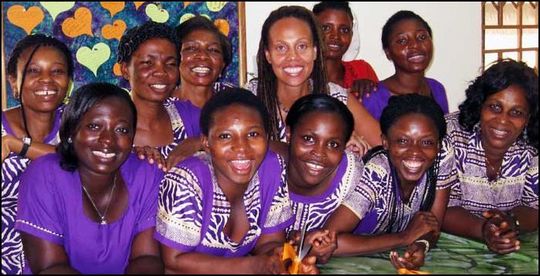
Photo courtesy of Baba Blankets
Accra, Ghana was colonized by the British which came in handy as Brown scoured the city in hopes of finding someone who could teach the women to sew. Tailoring is considered a highly skilled craft in Accra, so Brown hired tailors and seamstresses to teach the initial group of women how to do the most basic of sewing. Using her savings she purchased fabrics, dyes, and sewing machines. She opened the first studio cooperative in the market amongst the rats, crime, and open sewage on a daily basis. "We were creating beautiful items from this horrible place. Beauty can truly come from within each of us." During these trying times she was on a daily basis encouraged and inspired by the courage and strength that these women exhibited. They began creating items using locally produced fabrics while at the same time encouraging the women to design the patterns for the throw blankets and table cloths they were producing. They were off and running. By the end of the year they had sewn three hundred blankets. But how to sell them, and where? Again, Brown had no idea of how she was going to sell these items that would support the women who depended upon her.
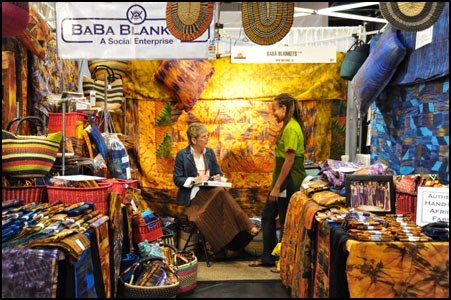
Photo courtesy of Baba Blankets
Brown returned to San Francisco and opened an art studio on a retired military base. Overwhelmed by the number of blankets and no idea what to do next she decided to write press releases about her endeavor and sent them out to all major newspapers, not sure if any would respond. She was thrilled when she was asked to be in the 1st Crossroads Cafe Art Show. That weekend the San Fransisco Chronicle devoted an entire front page in the arts section about Brown and the work she was doing in Ghana. When she returned from the show her phone never stopped ringing. Others were excited and supported her dream.
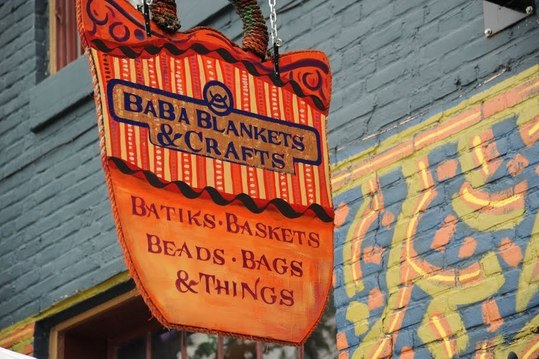
Photo courtesy of Baba Blankets
Fast forward to 2007 when Brown was asked to be a guest artist at the New Orleans Jazz Fest. The celebration that year was honoring the country of Ghana. Brown fell in love with New Orleans and the people of and in 2008 decided to move her operation there. It was in December of that year that she opened the store, Baba Blankets and Crafts named after the project Baba Blankets. Baba is a term of honor and respect given to a nurturing and guiding individual. The store features a range of items made by the women of the cooperative as well as other hand crafted items from Ghana that directly support the artisans. Along with the store in New Orleans, Baba Blankets has a web shop. To learn more about Baba Blankets and its mission click here.
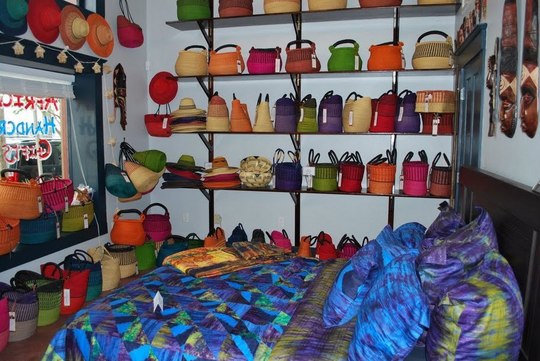
Photo courtesy of Baba Blankets
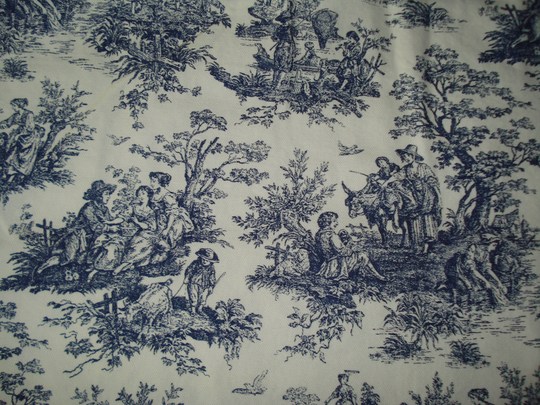
For the Love of Toile
by Lilo Bowman
Toile, or "cloth" in French, has been embraced by interior decorators and clothing designers (and--more recently--quilters) since the 1700s. Inspired by the demand for the exorbitantly priced printed cotton fabrics of India, Irishman Francis Nixon created what would come to be known as the first toile fabric in 1752. His printing technique soon spread to England and France; the French expanded the style and gave the textile its name.
To replicate the Indian prints, Europeans began by dipping a block of carved wood into paint. The paint-dipped block was then pressed onto fabric and struck with a hammer. This method was very time consuming, and did not yield the desired crisp and detailed prints. With the the invention of copperplating in the latter 18th century, fine and detailed designs could be carved and attached to rollers that allowed unending and repeating patterns to be printed onto fabric that was passed between them.

Chateau de l'Eglantine
The most famous toile is Toile de Jouy, created by Christophe-Phillipe Oberkampf, in the village of Jouy-en-Josas near Versailles, France. As a young boy, Christophe was apprenticed to a dyer. In 1760, at age 20, the young man began producing his first fabrics in a small cottage. He was the designer, engraver, and printer. With the advent of the copperplate printing process, the much-loved, one-color prints of mauve, blue, puce, and red came into being. At this same time, new "French" patterns were replacing the traditional Indian motifs. Scenes depicting families picnicking, couples dancing, or idyllic scenes of farm families at work charmed stitchers as much back then as they do in present day.
The love which the people of France feel towards Oberkampf and the printed fabrics he manufactured between the years 1760-1843 has been lovingly preserved in the Chateau de l'Eglantine. Oberkampf's drawing room has been reconstructed to recreate the atmosphere of his residence. It features wooden plates, copper plates and rollers, dyes, and silk-screen printing frames that illustrate the printing processes from the 18th century to the present day. The museum features a collection of over 5000 items relating to Oberkampf, as well as textiles from other French printing factories. To learn more about the museum and its collection, click here.
To view a quick and fun sewing project (Divided Roll Basket) featuring toile, visit Projects here.
Pam Holland is back! She has been very busy traveling the world.
Watch as she takes us to France and shows us the fabrics, the designs and the views from the Eiffel Tower.

"Paradise in the Garden" by Jean Wells
"Cottage Quilt Industries" Become Big Business in Late 20th Century:
Jean Wells Keenan of Sisters, Oregon
By Karen B. Alexander
Quilting in the 20th century has touched many lives in profoundly different ways. Some quilters have even gone on to create a business out of their passion that has enabled them to support themselves and even their children. A few have even put those children through college! But the one thing we quilters all seem to have in common is our love of color and the feel of the fabric beneath our fingers.
Last month I shared with you the success Ruby McKim experienced with her quilt pattern business in the first half of the 20th century and touched briefly on Marie Webster's quilt business success as well. These successes are only some of the contributions both women made to the quilt world that earned them induction into The Quilters Hall of Fame. Jean Wells Keenan of Sisters, Oregon fits right in with these two earlier multi-talented female entrepreneurs. Some call such businesses "cottage industries". However, Keenan took her talents as a teacher, designer, author and quilt shop owner to another level all together.
Lets look back for a moment. Interest in the various needle-arts tend to wax and wane with every generation. The fluctuating interest in quilting in the 20th century is no exception. Although much had previously been written about weaving and embroidery and even lace-making, it wasn't until the publication of Marie Webster's book "Quilts: Their Story and How to Make Them" that anyone had attempted to write a book solely dedicated to the history of the quilt. Webster's designs, which began to appear in 1911 in The Ladies' Home Journal, and her 1915 book set-off a new national interest in quilts. Marie's story* is a fascinating one, especially in light of all the quilt-related businesswomen that would come after her.
As the U.S. approached its bicentennial in 1976, the emergence of women's history as a separate field worthy of serious academic study is now a well-documented fact. The proliferation of serious quilt history followed shortly thereafter. The founding of the American Quilt Study Group (AQSG) in 1980 by Sally Garoutte specifically helped set high academic standards for this newly emerging field. Needlework "cottage industries" touches upon this month's subject -Jean Wells Keenan- a renowned quilter who would take her quilt business one giant step further in the late 20th century.
Cottage needlework industries were certainly not unheard of in the first quarter of the 20th century, but not all of them impacted the direction of quilt design to the degree that both Marie Webster and Ruby McKim did. An excellent paper by quilt historian Cuesta Benberry (1922-2007), "Quilt Cottage Industries: A Chronicle" established groundbreaking research on this subject. You can find Benberry's article in the 1994 hardback book, Quiltmaking in America: Beyond the Myths, published by AQSG. Amazon.com carries used copies.
Both Webster and McKim were forerunners of an explosion of similar quilt-related businesses that emerged during the late 20th century quilt revival. One only has to track the ads in the popular needlework and quilt magazines of the time to see these phenomena emerge. The Internet and other new technology only added to women's ability as well as opportunity to create and work from home at something they loved.
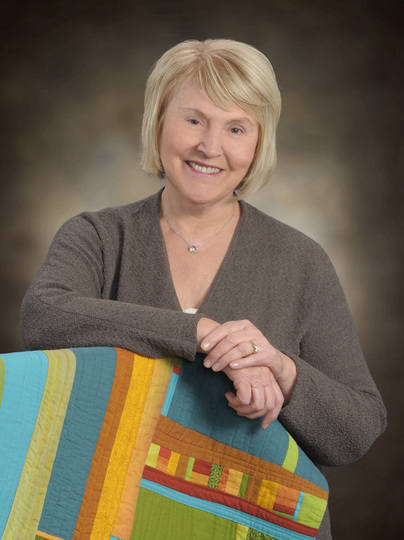
The life and career of our newly announced 2010 Inductee -Jean Wells Keenan of Sisters, Oregon-is an excellent example of the influence of one of the foremost quilt entrepreneurs of the late 20th century. Keenan came to her career in quilting through a serendipitous occurrence in her career as a Home Economics teacher in the Oregon public school system in the 1960s. However, her interest in sewing began far earlier in her childhood.
Although no one in the family quilted during the years Keenan was growing up, Keenan was fortunate to have a grandmother who greatly enjoyed sewing and crochet and noticed the budding interest of her two granddaughters in sewing and encouraged them. Ah, what a difference a grandmother can make in a child's life. The seeds were thus planted, watered and tilled. What an amazing variety of creativity would one day emerge from such a humble beginning.
Many shifts were occurring in the fiber arts world in the second half of the 20th century that further set the stage for someone like Keenan. Addressing these changes in a 1993 Uncoverings article, Honoree Bets Ramsey wrote: "... between 1950 and 1970 certain artists began to adopt and incorporate various quilting techniques in their work, coinciding with a new awareness of the value of women's work and an acceptance of fiber as an art medium."
About this same time educators in the late 1960s began asking, "Why are we pushing only gender-specific Home-Ec and Shop classes? Girls need to learn to use tools and boys need to learn to survive in a kitchen and thread a needle." It was this particular cultural shift that was the catalyst for setting Keenan's interest in quiltmaking in motion.
In 1969, in the process of fulfilling her new curriculum requirement to find a project to assign to the boys in her class, Keenan came across some English patchwork in a book. What appealed to her were the geometric shapes. Geometry, numbers, math! What an excellent vehicle for teaching various lessons, not the least of which was accurate cutting and sewing! This was not frou-frou stuff as any quilter knows, as well as any engineer. Accurate measuring, dexterity at intricate assemblage and patience is something that any student can benefit from.
Keenan had the boys make floor cushions but was soon taken with the whole process of putting colorful fabrics together in a variety of new shapes. Having loved sewing and fabric since childhood, this new venue was right down her alley. It didn't matter that she had never seen quilts made. Patchwork was still sewing and it was done with a colorful variety of fabric and patterns. Piecing is piecing, right?
The 1960s and 70s also saw the rise of other events that stirred up new interest in the fiber arts: the first quilting cooperatives; the formation of numerous new quilt guilds across the country following the American Bicentennial; the introduction of quilt conferences, beginning with the creation of the Mill Valley Quilt Authority founded in Mill Valley, CA, in 1970 by Joyce Gross and Sally Garoutte; the creation of the National Quilting Association (1970) in Greenbelt, MD; the launch of Bets Ramsey's annual Southern Quilt Symposium in conjunction with Hunter Museum (1974) in Chattanooga, TN; and the creation of the Continental Quilting Congress by Hazel Carter in1978 and her subsequent creation of The Quilters Hall of Fame the following year. Jean Wells Keenan stepped onto this stage in the mid-70s, her talents and love of teaching now poised to take off in a whole new direction, and take off she did.

2009 Sisters Outdoor Quilt Show poster, by Dan Rickards
A year after moving to Sisters, Oregon, Keenan decided to use money from her teacher's retirement account to rent space where she could teach quilting as well as sell quilting supplies. That same year she also launched the first Sisters Outdoor Quilt Show. This was 1975, an auspicious year when you consider it in the context of the events listed above. Just a year or so earlier Keenan had also discovered old family quilts her mother had packed away in family cedar chests. What an exciting catalytic discovery that must have been for her as well! Quilts were not uncommon in her family after all!
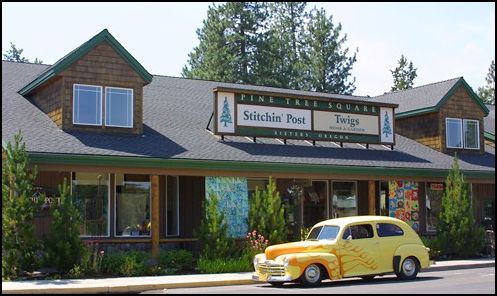
The Stitching Post Quilt Shop
When Keenan opened The Stitchin' Post in 1975, could she possibly imagine what lay ahead - an outdoor quilt show that would eventually exhibit some 1200 quilts each year from around the world and would utilize some 3,000 volunteer hours from a cooperative community to pull off; an annual week-long "quilt school" showcasing some 30+ teachers; 27 books, including the 11 she has co-written with her daughter Valori Wells Kennedy? Perhaps not; but in fact because of those first steps she dared to take, the dream became a reality, enhancing countless lives.

Visitors at the 2008 Sisters Outdoor Quilt Show
The impact of the growth of the Sisters Outdoor Quilt Show on the community of Sisters, Oregon is not difficult to imagine. With the surge in interest in quilting following the U.S. Bicentennial, the Quilt Show grew so large that a non-profit corporation was eventually established to manage the show and related events for the benefit of the Sisters community and school groups, and to educate the public about the art of quilting. This is one of those rare occurrences in quilt history where quilting changed a whole community. This in itself sets Jean Keenan Wells apart from the average quilt shop owner.
This amazing woman's impact continued to expand year after year. In 1979 she wrote her first book. In 1980, the year after Hazel Carter founded The Quilters Hall of Fame as an adjunct of the Continental Quilters Congress, Keenan added the Quilter's Affair, a week-long schedule of workshops that coincides with the Quilt Show. Today it attracts close to 1600 participants from all over the world. Whole families drive to Sisters each year and camp out for the week so that the quilter in the family can attend classes. The estimated numbers for the over-all crowd that is attracted to Sisters each year - some just to see the quilts and to shop - is 15,000-20,000. Keenan further assists the community by hiring local high school students to tote sewing machines and materials to and from classes each day; play jazz during Picnic in the Park; set-up and serve and clean up the Picnic in the Park for 800+ guests; conduct the Around the Block Fiber Art Stroll; plus pick up trash throughout the weekend.
Always one to be deeply involved in community activities, Jean Wells Keenan served on the Sisters School Board from 1975-1978, (chairing the committee 1977-1978), and early on became an active member in the Sisters Area Chamber of Commerce, a relationship she maintains today. In 1984 she became a participant in the Central Oregon Community College Small Business Development Program, and later became an advisor to the Oregon State Board of the Small Business Program, as well as a Board member for the Central Oregon Economic Development Council 1989-1991. The Sisters Area Chamber of Commerce honored Keenan's commitment to the community by presenting her the Business of the Year Award in 1999 and Citizen of the Year in 2008. As one letter nominating Keenan to the hall of fame read, "To name all who she has encouraged to develop their full potential would simply be impossible."
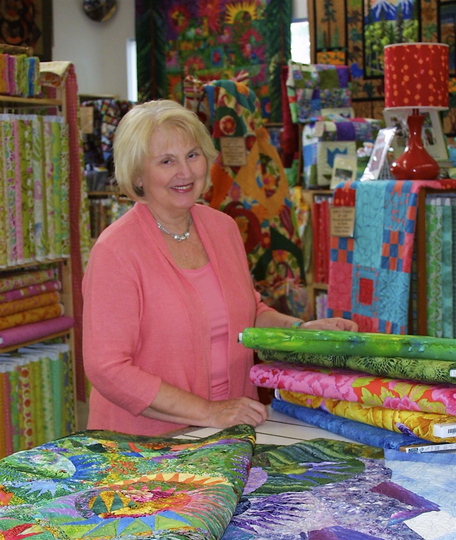
It is quite possible that The Stitchin' Post is the oldest quilt shop in the U.S. Certainly it's the oldest quilt shop still in the hands of its original owner. In acknowledgement of her business acume, Keenan was named recipient of the Michael Kile Award for Lifetime Achievement in 1998, the highest award that the quilting business industry gives. She was also the first quilt shop owner to be inducted into the Independent Retailer Hall of Fame in 1997. In 2008 she was one of eight Oregon State University alumni honored in its year-long Centennial Celebration salute.
Keenan is indeed a major player in today's evolving "quilt world," with its far-reaching impact on commerce, manufacturing, and related technology. She has also made many contributions to the beauty and aesthetics of this well loved art form and has traveled the world to teach both quilting and the business of successful quilt shop management.
Active for almost three decades as a noted quiltmaker, author, designer, teacher and entrepreneur, Keenan has managed to stay on top of a fast paced and changing retail business while working successfully to pass responsibility on to the next generation when she took on her daughter Valerie Wells Kennedy as her partner in 2005.
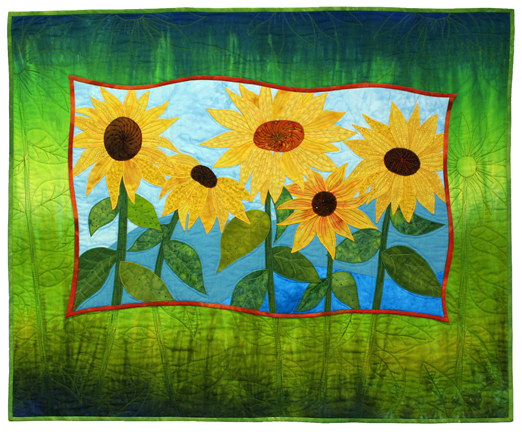
"Sunflower of Provence"
Keenan is also a passionate gardener and, like Marie Webster, her gardens greatly inspire and influence her quilt designs.
In writing all of the above, we haven't even touched upon Keenan's award winning quilts, some of which you can see here, or her gifts as a designer.
There is so much more to explore about this talented, generous business woman and quilter. Keenan is well deserving indeed of the honor of becoming The Quilters Hall of Fame's 40th inductee. Mark your calendars for July 15-17, 2010 and come celebrate with her. Although the Celebration 2010 Registration form for Keenan's induction won't be available until April, there are other interesting news items to see on both the TQHF website and on the TQHF blog between now and Celebration 2010.
Meanwhile, keep those needles flying and spread the word about how quilts enrich your life as well as the life of our communities!
Karen B. Alexander
Quilt Historian
Sources:
1) The Alliance for American Quilts, Q.S.O.S. Tape No. 71; interview of Jean Wells Keenan by Leah Call, November 3, 2003
2) Bend Bulletin, Bend, Oregon, May 5, 2009; interview of Jean Wells Keenan by Kimberly Bowker [ add live link to http://www.bendbulletin.com/apps/pbcs.dll/article?AID=/20090505/BIZ0102/905050352/1005/NEWS01&nav_category=NEWS01]
3) Bets Ramsey, "Art and Quilts: 1950-1970", Uncoverings 1993, Laurel Horton, ed. (San Francisco: American Quilt Study Group, 1993) 9-40
4) C&T Publishing: The Stitchin' Post named an Inspirational Shop.
5) Letters of nomination from The Quilters Hall of Fame archives: Ann Foster of Oregon; Alex Anderson of California; Karey Bresenhan of Texas; Kathy Pazera of Oregon; Donna Wilder of New York; Kathie Olson of Oregon
6) Oregon State University Synergies
*Marie Webster's granddaughter, Rosalind Webster Perry, republished this seminal work in 1990 but added a comprehensive must-read chapter about Marie's own life and business. "Quilts: Their Story and How to Make Them" is available through the TQHF Museum Shop.
Every quilt artist approaches a new piece in a method that best suits them personally. Some map out the entire design before ever cutting into fabric. Others have an idea, but just dive in letting the quilt speak to them as they go along. No matter what the technique, being able to follow along during the entire process as a spectator is a rare treat.
Several months ago we shared with you the story behind the creation of this quilt named "Grandmother's Legacy" here. During the next few weeks we will bring you four slide show installments that follow along during the creation of this quilt whose idea began with a black and white photo of Alex Anderson at her grandmother's knee seen at the Silver Star Awards in Houston last fall.
In Part I we begin with a beautiful piece of batik fabric that Gail Thomas saw as the perfect canvas for painting this sweet domestic scene. Using layer upon layer of Angel paint, Gail brings depth and life to the three individuals in the photograph.
Here are the links for the other Smilebox progressions Grandma's Legacy II
Paducah is a very special event. Every year 35,000 quilters descend on this quaint town in Kentucky, USA. It was an eye-opening experience for our travelling Australian quilting teacher. Here is a fun review of events through Pam Holland's eyes.
Just a reminder that Pam has one of the best blog/websites in quiltdom. Click Here.